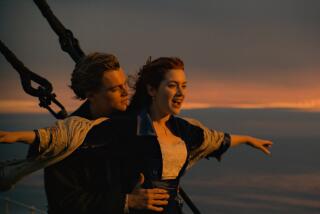Critic’s Notebook: The Titanic in Bob Dylan’s ‘Tempest’
Bob Dylan
“Tempest”
(Columbia)
Bob Dylan’s new album, “Tempest,” which arrives Sept. 11, is already generating considerable attention for the title track, his take on the sinking of the Titanic during the centenary year of the tragic disaster at sea. And rightly so — it’s one of the most extraordinary compositions from the most acclaimed songwriter of the rock era.
We’ll have an in-depth review of the entire album by Times pop music critic Randall Roberts in the days ahead, but here are some thoughts about the album’s centerpiece track, which clocks in at just under 14 minutes.
Elsewhere on the album, Dylan and his crack touring band again mine rootsy grooves as the settings of a dizzying array of topics that the Bard of Hibbing, Minn., has elected to tackle during this 50th anniversary year of the release of his 1962 debut album, “Bob Dylan.” In a couple of instances, he magically works a simple chord or two for entire songs.
PHOTOS: Iconic rock guitars and their owners
For “Tempest,” he’s conjured up an Irish-Celtic waltz feel as he chronicles this oft-told tale, in a voice as tattered as a shattered china cup, across 45 verses with no chorus. Because everything Dylan does becomes fair game for fan and critic speculation, it’s hard not to wonder whether, consciously or unconsciously, he also chose to write the song without a bridge, either, knowing the passengers and crew on the ill-fated liner had none at their disposal.
It’s been widely reported that Dylan drops the name “Leo” into the song, name-checking the fictional protaganist of James Cameron’s hit 1997 film version, but it wasn’t until my second hearing of the song that I realized he’s also tipping his hat to Kate Winslet’s character, Rose, in the opening verse:
The pale moon rose in its glory
Out on the western town
She told a sad, sad story
Of the great ship that went down
Dylan’s not only putting his own spin on the Titanic story — one that brings the artist’s perspective that allows the facts to take on a different, deeper resonance than just hearing them dryly recounted — but he’s celebrating an earlier age when tragic songs spun off the news of the day were commonplace in our culture.
Songs that grew out of World War I turned out to be some of the biggest hits of the second decade of the 20th century, among them Henry Burr’s 1918 hit “Just a Baby’s Prayer at Twilight (for Her Daddy Over There),” the American Quartet’s “Over There” in 1917 and Irish tenor John McCormack’s “It’s Long Way to Tipperary” in 1915.
Musical treatments of the Titanic story began popping up within days of the sinking. Musicologist A.E. Perkins in 1922 reported that “The Titanic sank on Sunday, April 14, 1912. The following Sunday I saw on a train a blind preacher selling a ballad he had composed on the disaster. The title was ‘Didn’t That Ship Go Down?’” Another, “Titanic (Husbands and Wives),” a.k.a. “It Was Sad When That Great Ship Went Down,” has become a contemporary folk classic often reprinted in the pages of camp songbooks.
PHOTOS: Iconic rock guitars and their owners
Dylan himself is a PhD-level musicologist, and he exhibited his passion regularly during the run of his weekly satellite radio show “Theme Time Radio Hour.”
The second verse of the song casts the story in terms that take it beyond mere mortal tragedy into the realm of the mythological:
’Twas the fourteenth day of April
Over the waves she rode
Sailing into tomorrow
To a golden age foretold
And then Dylan injects an intriguing sense of mystery and foreboding fatalism into the third verse:
The night was bright with starlight
The seas were sharp and clear
Moving through the shadows
The promised hour was near
“Promised hour”? Who might have promised such an hour, and why?
Soon, he introduces the character of the ship’s watchman, who will reappear three more times before the song’s end. Dylan subtly, even wittily, alludes to him being asleep on the job.
The watchman he lay dreaming
As the ballroom dancers twirled
He dreamed the Titanic was sinking
Into the underworld
Then life imitates art with the allusion to the invented element from Cameron’s film:
Leo took his sketchbook
He was often so inclined
He closed his eyes and painted
The scenery in his mind
As with nearly every subject Dylan addresses, this one occupies more than one level of meaning. Tragic as the loss of life on Titanic was, the tale resonates so deeply because of the more complex issues it touches in terms of human hubris, as well as the analogies to the ship of state inherent in any story of a seagoing vessel.
He heard a loud commotion
Something sounded wrong
His inner spirit was saying
That he couldn’t stand here long
The reference to an “inner spirit” implies an outer spirit and in this context suggests an inner transformation under way. And sure enough, Dylan sees an earthly disaster in spiritual terms, and ominously spiritual at that:
The ship was going under
The universe had opened wide
The roll was called up yonder
The angels turned aside
He makes no mention of an iceberg, or lifeboats, but conjures the scene better than on-site hi-def cameras with his words:
Passengers were flying
Backward forward, far and fast
They mumbled, fumbled, tumbled
Each one more weary than the last
Along the way he notes acts of cowardice and bravery, horror and heart-rending sacrifice as the ship lists in the frigid waters of the North Atlantic:
Mothers and their daughters
Descending down the stairs
Jumped into the icy waters
Love and pity sent their prayers…
Jim Dandy smiled
He never learned to swim
Saw the little crippled child
And gave his seat to him
He captures what surely must have been the Titanic captain’s sense of overwhelming helplessness as he realized what was happening:
The captain, barely breathing
Kneeling at the wheel
Above him and beneath him
Fifty thousand tons of steel
Like his biggest songwriting mentor, Woody Guthrie, Dylan excavates broader truths out of what in others’ hands are mere facts about those who perished, those who survived and those who watched from a distance:
When the Reaper’s task had ended
Sixteen hundred had gone to rest
The good, the bad, the rich, the poor
The loveliest and the best
They waited at the landing
And they tried to understand
But there is no understanding
On the judgment of God’s hand
A half-century down the line, Bob Dylan is at the absolute top of his game. And that’s just one song. Elsewhere he offers a touching and oblique benediction on the death of John Lennon in “Roll On John,” crafts a deliciously dark murder ballad in “Tin Angel,” and kicks the album off with a rollicking, bluesy metaphorical train ride in “Duquesne Whistle.”
I leave the rest to Randall, who’ll have more to offer soon.
ALSO:
Rolling Stones to play U.S., U.K. shows in November?
Spike Lee bringing Michael Jackson documentary to ABC
Video: Taylor Swift’s ‘We Are Never, Ever Getting Back Together’
PHOTOS AND MORE:
PHOTOS: Iconic rock guitars and their owners
PHOTOS: The Rolling Stones at 50
INTERACTIVE: Pick the next ‘American Idol’ judge
More to Read
The biggest entertainment stories
Get our big stories about Hollywood, film, television, music, arts, culture and more right in your inbox as soon as they publish.
You may occasionally receive promotional content from the Los Angeles Times.










